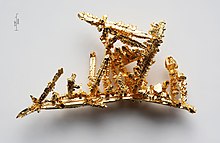

In chemistry, a chemical transport reaction describes a process for purification and crystallization of non-volatile solids.[1] The process is also responsible for certain aspects of mineral growth from the effluent of volcanoes. The technique is distinct from chemical vapor deposition, which usually entails decomposition of molecular precursors (e.g. SiH4 → Si + 2 H2) and which gives conformal coatings. The technique, which was popularized by Harald Schäfer,[2] entails the reversible conversion of nonvolatile elements and chemical compounds into volatile derivatives.[3] The volatile derivative migrates throughout a sealed reactor, typically a sealed and evacuated glass tube heated in a tube furnace. Because the tube is under a temperature gradient, the volatile derivative reverts to the parent solid and the transport agent is released at the end opposite to which it originated (see next section). The transport agent is thus catalytic. The technique requires that the two ends of the tube (which contains the sample to be crystallized) be maintained at different temperatures. So-called two-zone tube furnaces are employed for this purpose. The method derives from the Van Arkel de Boer process[4] which was used for the purification of titanium and vanadium and uses iodine as the transport agent.

- ^ Michael Binnewies, Robert Glaum, Marcus Schmidt, Peer Schmidt "Chemical Vapor Transport Reactions – A Historical Review" Zeitschrift für anorganische und allgemeine Chemie 2013, Volume 639, pages 219–229. doi:10.1002/zaac.201300048
- ^ Günther Rienäcker, Josef Goubeau (1973). "Professor Harald Schäfer". Zeitschrift für anorganische und allgemeine Chemie. 395 (2–3): 129–133. doi:10.1002/zaac.19733950202.
- ^ Schäfer, H. "Chemical Transport Reactions" Academic Press, New York, 1963.
- ^ van Arkel, A. E.; de Boer, J. H. (1925). "Darstellung von reinem Titanium-, Zirkonium-, Hafnium- und Thoriummetall". Zeitschrift für anorganische und allgemeine Chemie (in German). 148 (1): 345–350. doi:10.1002/zaac.19251480133.